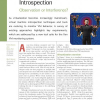Free Online Productivity Tools
i2Speak
i2Symbol
i2OCR
iTex2Img
iWeb2Print
iWeb2Shot
i2Type
iPdf2Split
iPdf2Merge
i2Bopomofo
i2Arabic
i2Style
i2Image
i2PDF
iLatex2Rtf
Sci2ools
IEEESP
2008
2008
Virtual Machine Introspection: Observation or Interference?
hardware, eliminating an abstraction layer and often improving efficiency as a result. Examples of type 1 systems include VMware ESX,3 Xen (www. xensource.com/xen/xen/nfamily/virtualpc/default. mspx), and Microsoft Hyper-V (http://technet2. microsoft.com/windowsserver2008/en/server manager/virtualization.mspx). In a type 2 system, the VMM uses an OS as an interface to the physical hardware. Type 2 systems include VMware Workstation, the QEMU open source process emulator (http:// bellard.org/qemu/), KVM (http://kvm.qumranet. com/kvmwiki), Parallels (www.parallels.com), and Virtual PC/Server (www.microsoft.com/windows/ products/wi). Type 2 systems rely on the underlying OS to provide hardware interaction and device drivers, and thus often have a wider range of physical hardware components to interact with. To illustrate how virtualization works, we'll examine a simplified event sequence that occurs when a process attempts to access a memory address in its
| Added | 10 Dec 2010 |
| Updated | 10 Dec 2010 |
| Type | Journal |
| Year | 2008 |
| Where | IEEESP |
| Authors | Kara L. Nance, Matt Bishop, Brian Hay |
Comments (0)

